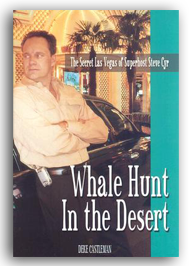 Whale Hunt in the Desert: The Secret Las Vegas of Superhost Steve Cyr
Whale Hunt in the Desert: The Secret Las Vegas of Superhost Steve Cyr
by Deke Castleman
By most accounts, Steve Cyr revolutionized the ways in which casinos worldwide cater to the whims of “whales”, the highest rolling gamblers in the world. Flying in the face of received wisdom, his mass marketing and customer service approach to the business upset decades of tradition but ultimately set the standard for the gambler-casino host relationship. Cyr now works personally with the world’s biggest gamblers, Michael Jordan being one of the few names he’s allowed to mention. He most likely has a fascinating job and life.
Deke Castleman’s Whale Hunt in the Desert, though, is not so much a biography or memoir of Steve Cyr as it is a history and exposition of the ways in which Las Vegas caters to, and does battle with, the biggest gamblers in the world. In fact, the chapters that explicitly focus on Cyr are the least interesting, reading as though they were written by an adoring fan (or, as is perhaps more likely, by Cyr himself). Elsewhere, though, Whale Hunt is a fascinating, entertaining, and funny distillation of Las Vegas gambling culture.
An interview with Cyr on the Two Plus Two Pokercast first piqued my interest in this book. Cyr was funny and insightful, telling a few good stories of high-roller degeneracy and hinting at many more. I picked up Whale Hunt in the Desert hoping to find an anthology of these stories.
I nearly put it down when the first few chapters proved to be a star-struck account of Cyr’s rise from telemarketer to super-host to the stars. Castleman unapologetically paints Cyr as an underappreciated genius persecuted by the “dinosaurs” who were responsible for servicing the casinos’ biggest players, or whales. Cyr himself is not nearly as interesting as his customers and his interactions with them, yet the book’s early chapters are loaded with trivial details of his young life.
Thankfully, Castleman soon turns away from Cyr to examine the early efforts of the Las Vegas casinos to rope in bigger gamblers in the 1980’s. Though Steve Wynn was initially criticized for spending hundreds of millions of dollars building the Mirage, with its volcano erupting hourly on the Strip, his super-casino’s immediate success quickly spawned a wave of imitators. Soon, the major casinos were competing to offer the swankiest villas, priciest shopping sprees, and most coveted show tickets to the same handful of six- and seven-figure players.
Castleman chronicles the emergence of these perks and highlights the most extravagant ways in which high-end casino hosts barter food, liquor, sex, and drugs for a shot at a multi-million-dollar bankroll. It seems Cyr’s contribution, which the author never fails to point out, was proving that “if you comp it, they will come.” According to the author, Cyr cajoled his bosses into making substantial up-front investments in individuals who, with the proper cultivation and cajoling, had the potential to become giant whales. Such players now routinely receive private jet and limousine transportation, hundreds of thousands of dollars in “appearance fees” (cash received up front for agreeing to play at a particular casino), and discounts on their losses in addition to luxurious accommodations and round-the-clock butler and concierge service.
I was surprised to learn just how small the house edge can end up being by the time these high-end comps are accounted for, though of course a small edge on millions of dollars wagered still translates into serious profit. Nevertheless, many accountants fear the biggest whales. It seems that casinos generally do not have the bankrolls to absorb the variance that a big-money craps player brings with him, and some actually discourage the largest wagers for fear of eating a loss that could crush their quarterly profits and consequently the value of their company’s stock. Castleman even suggests that the biggest gamblers, who are often savvy business executives, sometimes capitalize on their winning sessions by shorting a casino’s stock after leaving the table with millions in profit.
Though Castleman fawns entirely too much over Cyr, he does occasionally call him to account, most notably in a chapter on the ethics of casino hosting. By Cyr’s own recokoning, he considers many of his customers to be friends yet admits that approximately one-third of them cannot afford to lose the money that he encourages them to gamble away. Cyr, while claiming that his goal is never to break a player but rather to “bleed” him over many years, concedes that more than a few have lost life savings, bankrupted businesses, and ruined marriages on his watch. The author does not take his subject fully to task, but he does cast a critical eye on Cyr’s apologetic that there was nothing he could do and that the players would have lost the money to a different casino if they hadn’t lost it to his.
Trivial biographical details and hero-worshipping aside, Whale Hunt in the Desert is a fascinating introduction to the world of high-stakes gambling in Las Vegas. The focus is not on anecdotes of extravagance and degeneracy, though there are a few, but rather on the gamble that the casinos themselves undertake when they match wits, and bankrolls, with the world’s biggest players.

Tremendous book. Still holds up, and nothing has been written about Vegas from the casino host/whale perspective since. Other than bits in the Steve Wynn book maybe…